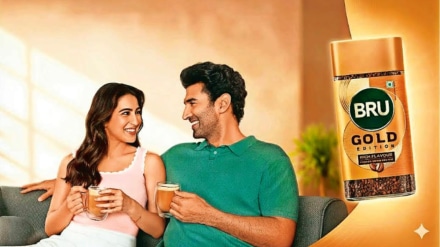Hindustan Unilever (HUL) recently relaunched its Bru Gold brand with a new campaign featuring actors Sara Ali Khan and Aditya Roy Kapur. With coffee consumption in India undergoing significant shifts driven by a slew of new-age players and homegrown coffee chains, Bru’s relaunch is aimed at driving consumer preference by promising a “superlative coffee experience.”
India has, by and large, been a tea-drinking nation but the coffee-drinking culture is on the rise. The coffee market in India stands at `9,000 crore but is growing over 2X the global average, according to market research firm Euromonitor. Nestle’s Nescafe leads the market with about 40% share. Bru, which had surpassed Nescafe in market share some 10 years ago, follows closely with an estimated 33% of the category. Other players in the market that is growing at around 10% annually include Tata Coffee, Continental and Davidoff. The entry of international coffee chains like Tim Hortons, Starbucks and Gloria Jean’s Coffees and the mushrooming of homegrown artisanal brands and chains such as Blue Tokai, Sleepy Owl and Third Wave Coffee has given the category a big push in recent years.
“The instant coffee market in India is driven by a growing urban consumption base and higher disposable incomes. Millennials and Gen Z consumers, specifically in urban areas, are the fastest-growing segments in instant coffee. They are usually also the most open to experimenting with new brands,” says Shabal Goel, vice-president, Avalon Consulting. While Nescafe leads nationally with a strong legacy position, Goel observes that Bru has a stronghold on the Southern markets.
There is an opportunity for brands here to carve out a differentiated image, one that highlights premium flavours. This requires making coffee feel aspirational rather than routine.
To drive consumer preference, Bru will need to “sell moments, not just coffee,” remarks Shekhar Suman, co-founder of Brandshark. “Bru’s premium refresh is a strong first step, but it needs to build a distinct cultural identity rather than just a product-based one. While Nescafe owns the energy and ambition space, Bru should own the emotion and connection space in a modern way,” says Suman. The brand can do that by way of owning the home café culture and product innovation such as flavoured variants and limited edition collaborations.
Breaking the mould
The challenge before Bru is twofold, as brand strategy and management consultant Sanjeev Shukla points out. First, Nescafe is almost synonymous with the instant coffee category, and second the category itself is low involvement compared with coffee brewed by the consumer herself.
Experts agree that Nescafé has, over the years, created a strong legacy for itself and that the brand’s strength comes from value addition and omnichannel distribution. Bru is positioned more as a family coffee brand, a kitchen staple steeped in tradition rather than innovation, limiting emotional resonance with younger consumers.
“Nescafé is an old brand, but its advertising has consistently reflected vivacity and invigoration. Bru has to catch up and a TVC for Bru Gold alone will not suffice. Relentless presence on digital, TV and print, corporate partnerships and setting up of dispensing units in popular market squares and malls are some of the ways Bru can create a better brand presence and experience for consumers,” notes Shukla, adding that disruptive storytelling and influencer marketing with young creators can help the brand create a more youthful appeal.
Nescafe also benefits from a network of over 1,000 Nestle India kiosks under the ‘Retail ONE’ initiative, offering consumers products from its portfolio including Maggi and KitKat. HUL had launched their Bru World Cafes back in 2011, but these were shut down five years later in 2016. HUL had said back then that the cafes were a way to gain learnings to focus on innovations for the Bru brand.
On the experiential front, Suman recommends that the brand should look to create ‘pop-up micro cafes’ in high-footfall youth zones. The goal shouldn’t be to mimic Nescafe’s footprint but to build experiential intimacy, blending product trials with content creation and community. That way, Bru can make the café experience its own, without losing its mass accessibility, he sums up.
